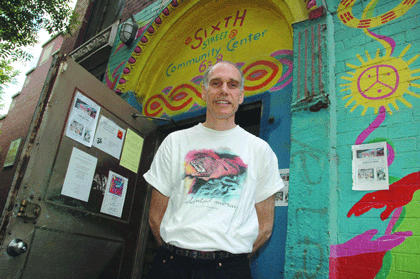By Jefferson Siegel
Walk east on Sixth St., past the tranquil 6 B/C Botanical Garden, the red-brick former Industrial School building and the Iglesia de Dios Church of God. Just beyond is a former synagogue.
Long ago the area was home to many synagogues, built to fulfill the spiritual needs of the predominantly Eastern European population. Years passed, families moved and the houses of worship fell into disuse. In the late 1970s, Maria Cruz, a local resident who worked with the Children’s Aid Society, squatted the empty three-story structure near Avenue C. Her group, the 6th St. Block Association, would become the Sixth Street Community Center.
One day in 1978, Howard Brandstein walked into the building just as several old marble plaques were about to be removed from an interior wall. The plaques were inscribed in Hebrew with the names of past congregants going back over a century. Brandstein asked the workers if they would agree to preserve the plaques. They assented and Brandstein signed up as a volunteer, the start of his nearly three-decade-long association with the center. When Cruz left in 1990, Brandstein took over as the community center’s executive director.
“Maria’s vision was a youth center — children, girls,” Brandstein recalled. “We were running summer camp programs and after-school programs,” he said of those early days.
In the 1980s, the community development division of the Save The Children Federation offered financial help for the building’s purchase. The center incorporated, the money was provided, the congregation agreed to sell and the center had a secure home.
Brandstein set about organizing the building’s renovation as well as a series of community-oriented classes and events, with an eye toward enriching and informing the lives of the young children of Loisaida.
In the mid-’90s, with an established volunteer base, the center shifted its focus to teens and nutrition issues. The health food movement wasn’t very prevalent at the time, making Brandstein a neighborhood visionary.
“The incredibly high rate of asthma in the neighborhood, the ridiculous number of kids who were being put on Ritalin and even Prozac, the skyrocketing rates of cancer,” he said he believed, all could be traced to a common source: poor nutrition.
Neighborhood reaction was positive.
“In the Puerto Rican community there’s a very strong connection with farming and agriculture,” Brandstein noted. Teen volunteers from the center were put to work on a farm, in a community garden and in the center’s kitchen to learn the fundamentals of a healthy lifestyle. Soon there were classes offering yoga. The politics of food was dissected in seminars examining the image of a family farm as a business conglomerate promoting genetic engineering.
Those classes evolved into current projects involving community-supported agriculture, SOS Food — a local group organizing to stop genetically engineered food — and one other popular nutrition-oriented activity.
“We call it the Seeds to Supper program,” Brandstein explained. “It will entail a summer program with teens working on a farm, doing healthy food preparation. It will be a training and educational piece. During the school year, they’ll get to apply what they’ve learned in one of our programs.”
One source of volunteers is the local school system.
“The schools now have these intern requirements, so they actually call us to see if they can place students with us,” Brandstein noted.
Interest among young people is high.
“If we had a hundred slots, we’d fill it,” he said. However, currently, “We can only do 10 to 15,” he said.
The Sixth St. Community Center has also brought teen volunteers to the local credit union for instruction in personal finance. And restaurants hold lunches for a firsthand look at the food service business.
The volunteers’ enthusiasm is exemplified in the dedication of one teen, Citalic Jeffers, who often puts in six-hour days.
“I oversee the C.S.A. [community-supported agriculture],” the distribution of fresh organic produce from local farmers to neighborhood residents, she explained.
The C.S.A. program offers locals the opportunity to buy shares in farmers’ harvests. The growers are guaranteed a set income while participating members enjoy the fruits — and vegetables — of their organic labors.
Jeffers, 16, an 11th grader at the High School for Environmental Studies, doesn’t just count vegetables. In addition to fundraising and writing grants, this young dynamo rewrote the Seeds to Supper program, bringing a six-week program to year-round status. This endeavor brings teen volunteers to local farms to learn and experience organic farming firsthand. They then bring that knowledge back to the community gardens of Loisaida and, ultimately, their homes.
“I helped out a volunteer with sending out a mailing list,” Jeffers continued, “and shortly thereafter they asked me if I wanted to work during the summer. I said, ‘Yeah, sure.’” Jeffers is now an intern at the center.
The center has long been an incubator for local activism, especially on housing, health and community gardens issues. Artists, squatters and homesteaders also find it a welcoming venue for places to meet, share ideas, perform and exhibit work.
Recent events have included last year’s Loisaida Photography and Film Festival. The documentaries “7th Street,” “Not For Sale” and “El Corazon de Loisaida” were screened at the center for old-timers and a new generation. Former Mayor Ed Koch stopped by to see one photo exhibit, in which he was the subject of some of the photos. Earlier this year, an all-night tribute to the iconic ’60s protest singer Phil Ochs was broadcast live on the radio from the center.
Earlier this month, a benefit was held for the Lower East Side/New Orleans Caravan, which the center is sponsoring. Brandstein explains it’s “sending people to New Orleans — volunteers, carpenters, electricians and other workers, artists, as well — to assist in the rebuilding.”
The benefit raised money to cover transportation costs for 15 people who, at the end of April, will travel to the storm-ravaged area for 10 days. The volunteers will spread out into low-income communities under the guidance of Common Ground, a grassroots organization formed to work on rebuilding. Two earlier benefits at the community center raised money for residents living in the disaster-stricken area.
“Loisaida has this long history of homesteading and squatting,” Brandstein said of the upcoming trip down South. “There are people running around with lots of skills so let’s see what we can do to contribute as volunters.”
Walking the gentrified streets of the East Village leads to the obvious question: with an entire building at one’s disposal, why not open a fancy bar or restaurant?
“It depends on what you want to do with your life,” Brandstein answered. “I don’t want to run a bar.
“There’s always been a community movement of some sort in the country,” he offered. “I chose to be involved in that rather than personal material advance. You can accumulate all the money you want, but if the environment goes to hell, you can’t breathe your money and you can’t eat your money.”
Brandstein has more creative plans for the future. He’s aiming for a June 1 opening of a vegetarian cafe in the center’s ground floor. Plans call for 20 seats plus outdoor seating in the side yard, with proceeds intended to fund other programs at the center.
“We’d like to have a flourishing program in agriculture and culinary arts and be working with lots of teens in the neighborhood and beyond,” Brandstein added. “As crises deepen or emerge, we’ll be here for the community as a place where people can plan and gather and take action.”


















